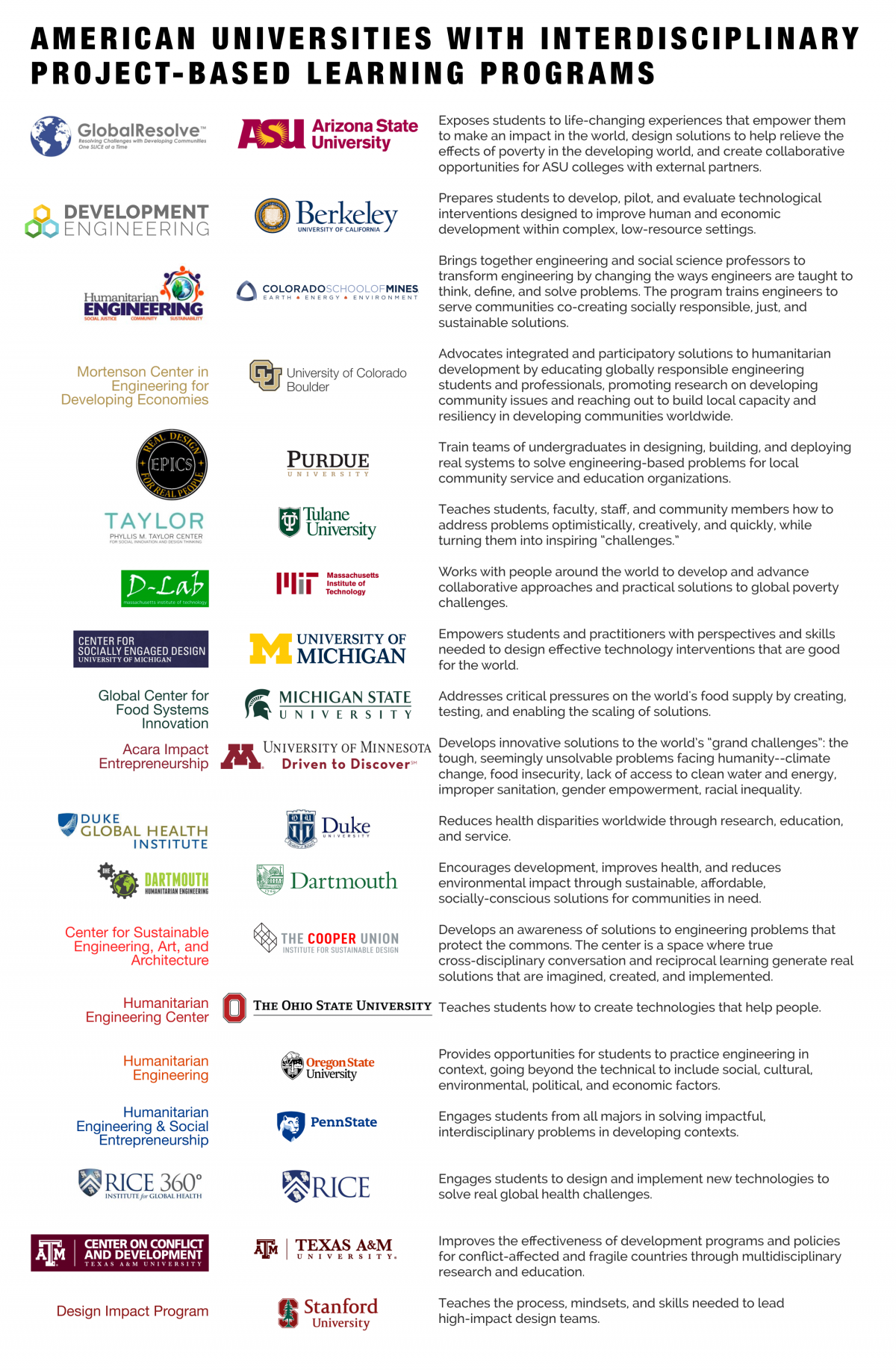By Nicole Rangel
College graduates with interdisciplinary and hands-on skills are in demand in today’s job market. Because they have exposure to more than one discipline and curiosity about the interplay of fields, these graduates are being positioned as necessary to solve societal challenges–from natural disasters and climate change to automation-induced unemployment and epidemics. This shift in academic training is a response to a growing recognition that social, governmental, and business challenges require the collaboration of people with educational training in engineering, law, business, physical science, medicine, agriculture, economics, urban planning, humanities, and computer science–and, most important, the ability to work together interdisciplinarily.
Yet offering curricula that aims to develop students’ interdisciplinary and project-based learning acumen is a challenge for many institutions of higher education. While there is substantial evidence to suggest this educational approach ought to be prioritized, we know little about academic programs that do prioritize education which prepares students to understand and engage with complex real-world problems.
The Blum Center for Developing Economies at UC Berkeley has begun to address this research gap by examining curricula that converges these two pedagogical approaches. The Blum Center is one of a number of academic programs across the country [see chart below] that offers hands-on learning experiences, which aim to help students understand their future roles outside the university. The center also facilitates interdisciplinary collaborations among students, researchers, and faculty to solve grand challenges in water, energy, education, healthcare, and wireless communications, among other areas.
 The Blum Center is home to Development Engineering, an interdisciplinary field at UC Berkeley created in 2014 that integrates engineering, economics, business, natural resource development, and social sciences to create,implement, and evaluate technologies that address the needs of people living in poverty. Development Engineering’s core class, DevEng 200, is organized around three thematic modules: 1) understanding the problem, context, and needs of a community receiving the intervention; 2) creating effective prototype technologies to social problems; and 3) field testing and assessing the impact of these technologies on the receiving communities.
The Blum Center is home to Development Engineering, an interdisciplinary field at UC Berkeley created in 2014 that integrates engineering, economics, business, natural resource development, and social sciences to create,implement, and evaluate technologies that address the needs of people living in poverty. Development Engineering’s core class, DevEng 200, is organized around three thematic modules: 1) understanding the problem, context, and needs of a community receiving the intervention; 2) creating effective prototype technologies to social problems; and 3) field testing and assessing the impact of these technologies on the receiving communities.
While the prototypes developed in courses like this one foster interdisciplinary understanding, it is still unclear how they cultivate intellectual strengths from one student in, say, mechanical engineering to another student in, say, public health. In other words, how is the sociological understanding of an engineering student or the design/evaluation skill of a public health student cross-cultivated in this course? How do students push themselves to learn skills that lay outside their expertise under the pressure of academic deadlines? And how do faculty assess aptitude of students in these interdisciplinary skills? The Blum Center is working to understand these questions as well as others, as it strives to provide project-based education that is rigorous not just in process, but also in its interdisciplinary content.
Research about project-based learning has mostly concentrated on K-12 education, and little exists on interdisciplinary project-based learning.Thus in our initial stage of inquiry, the Blum Center has reached out to over a dozen U.S. colleges and universities with academic programs similar to the Development Engineering graduate emphasis, to better understand the broader landscape of interdisciplinary project-based learning in higher education. We administered a short survey, and from the responses received have identified several areas in interdisciplinary project-based learning curricula that merit further investigation. They include:
- The experience of co-teaching, specifically between engineering and social science faculty, to better understand how co-teachers encourage interdisciplinarity among students from different majors.
- The need to identify best practices among faculty who have taught in this space, with complementary input from the participating students about their perceptions of these approaches.
- An assessment of the opportunities and challenges involved in interdisciplinary project-based learning, according to faculty and students. Because interdisciplinary project-based learning is not the norm, it is crucial to understand what faculty and students see as the incentive for engaging in this type of learning and what are the challenges in offering it.
Specifically, project-based learning has been credited for appealing to students’ motivations, strengthening their ability to problem-solve, refining their conceptual knowledge, and fortifying their sense of agency. Interdisciplinarity is recognized as fundamental for preparing students for democratic participation and is a growing imperative for U.S. colleges and universities at both undergraduate and graduate levels.
In line with what the literature suggests, the Blum Center sees promise in project-based learning, particularly when taught with an interdisciplinary approach. In the coming months, we will share a report that aims to deepen our understanding and ability to provide meaningful and effective education that not only benefits students, but also enterprises and communities around the world in need of support.
For an example of the Blum Center’s previous work in this area, see the Development Engineering Toolkit: Lessons on Implementing a New Multidisciplinary Program Uniting Engineering and the Social Sciences
Nicole Rangel is an educator and Ph.D. candidate in the Social and Cultural Studies of Education program at UC Berkeley.

